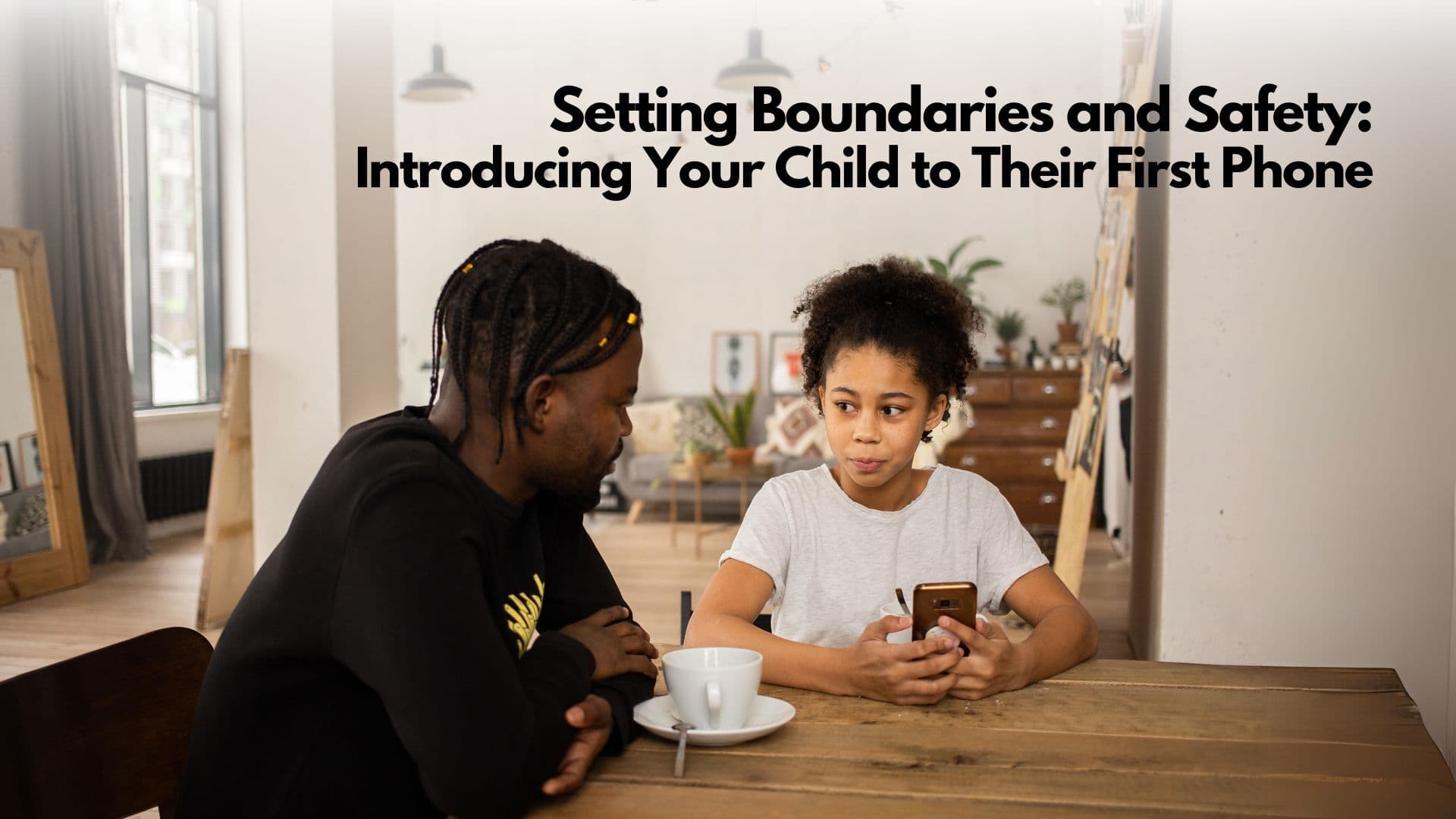We recently hosted a webinar on the essential topic of introducing children to their first mobile phone and ensuring their digital safety. We urge all parents and guardians to educate themselves and discuss with their communities the best practices for this significant milestone. A fantastic resource to begin with is Cyber Safety Cop’s latest webinar, “What You Need to Know Before You Buy Your Child’s First Phone.” This webinar covers crucial aspects, providing straightforward advice on how to prepare your child for responsible phone usage and safeguard their online experiences.
Deciding when to give your child their first phone can feel overwhelming. As technology becomes more ingrained in our daily lives, it’s important for parents to carefully consider how and when to introduce their child to a mobile device. This blog will provide simple and practical advice from experts to help you make choices that are right for your family.
Here, you’ll find straightforward tips and strategies to guide you through this important decision. Whether you’re worried about safety or just trying to figure out the right age for your child to start, we’ve got the information you need to move forward with confidence.
Understanding the Right Time
-
Assessing Needs vs. Wants: Deciding when to give your child their first phone involves careful consideration of their needs versus their wants. Safety is a common reason parents think about this step. Many feel that a phone is necessary to keep in touch with their child at all times, particularly during emergencies. However, it’s important to realistically assess your family’s daily routine and whether your current methods of communication are sufficient. If your child is mostly in secure environments like school or supervised activities where they have access to a phone in case of an emergency, then waiting a bit longer might be feasible.
-
Timing: It plays a crucial role in this decision as well. Experts often recommend delaying the introduction of mobile phones for as long as possible. The reasons are compelling: older children are typically better equipped to handle the responsibilities and challenges that come with owning a phone. These responsibilities can include managing screen time, understanding privacy settings, and handling online interactions responsibly. Waiting longer allows your child to develop a better sense of judgment and self-control, which are crucial skills in navigating both the digital and real world safely and effectively. Additionally, this delay gives you more time to discuss and prepare your child for the digital challenges they might face, ensuring they are better prepared when they finally do get their phone.
Choosing the Right Phone
-
Options for Younger Kids: When first introducing your child to mobile phones, starting with a basic model can be a wise choice. Simple devices such as flip phones are excellent for younger children. These phones typically offer limited functions that mainly include calling and texting. This limitation is beneficial as it minimizes your child’s exposure to the broader internet and various apps, significantly reducing the risks associated with online dangers and distractions. Such phones help introduce the concept of mobile communication in a controlled manner, allowing your child to focus on the essential skills of using a phone responsibly.
-
Smartphones: If you believe your child is ready for more advanced technology, or if their needs exceed the capabilities of a basic phone, a smartphone might be appropriate. When choosing a smartphone, look for models that are compatible with comprehensive parental control applications. Brands like Ourpact and Pinwheel specialize in creating smartphones tailored for children’s use. These phones come equipped with robust monitoring tools that allow parents to keep tabs on their child’s activities. Features might include managing screen time, blocking inappropriate content, and controlling app downloads. Importantly, these phones can adapt to your child’s growing independence, offering you the ability to gradually relax restrictions as your child matures and demonstrates responsible phone usage.
Setting Up for Safety
-
Parental Controls: Setting up parental controls on your child’s phone is a critical step and should be non-negotiable, regardless of whether you opt for a basic phone or a more advanced smartphone. These controls help you monitor your child’s activities on their device and filter out any inappropriate content they should not access.
-
Choosing Safe Apps: When it comes to installing apps, it’s important to focus on those that are essential and beneficial for your child’s age and maturity level. Non-essential apps can often lead to distractions or expose your child to less secure parts of the internet. Additionally, disabling the app store on your child’s device can prevent them from downloading new apps without your approval, which helps control their exposure to potentially unsafe content.
Discussing Online Safety
-
Open Communication: One of the most important steps you can take as a parent is to maintain open and ongoing communication with your child about the online world. Regular discussions are essential not only to inform them of the potential dangers but also to build trust so they’ll feel comfortable coming to you with their concerns. Topics should include the importance of privacy, such as why it’s crucial not to share personal information like addresses or phone numbers online. You should also talk about the potential consequences of online interactions, such as how speaking to strangers online can be unsafe and the long-term impact of posting inappropriate content. These conversations can help your child understand the digital environment and navigate it more safely.
-
Contractual Agreement: Creating a mobile device contract can be a practical approach to managing your child’s phone use. This agreement should lay out clear rules and expectations about how the phone should be used, including what types of behaviors are acceptable and what are not. It should also clearly state the consequences of misusing the phone, such as loss of privileges or restrictions on usage if rules are broken. This contract not only helps set boundaries but also involves your child in the process, making them more likely to follow the guidelines and understand the seriousness of their responsibilities when using their phone.
-
Teach Responsible Use: As parents and guardians, you can take a proactive step towards enhancing your children’s digital literacy by enrolling them in our Digital Citizenship course. Tailored for students in 1st through 3rd grade and 4th through 8th grade, this program is specifically crafted to equip them with essential skills, providing a solid foundation to navigate the digital world responsibly.
Balancing Screen Time
-
Creating Boundaries: It’s important to establish specific rules around when and where your child can use their phone. Setting clear boundaries helps ensure that phone use does not interfere with essential aspects of their life such as schoolwork, sleep, or quality family time. For example, you might decide that no phones are allowed during meal times, homework hours, or after a certain time in the evening to help them wind down before bed. These guidelines not only prevent excessive screen time but also teach your child to manage their time effectively and prioritize important tasks over digital distractions.
-
Encourage Offline Activities: Encouraging your child to engage in physical activities and hobbies that don’t involve screens is crucial for their overall development and well-being. Activities like sports, reading, playing a musical instrument, or engaging in arts and crafts can provide valuable opportunities for learning and personal growth. These activities not only offer a break from screen time but also help develop various skills and interests that contribute to a healthier lifestyle. Additionally, spending time outdoors and interacting with peers in person can improve physical health and social skills, reducing the risk of screen addiction and its associated negative impacts on mental and emotional health.
Parental Involvement and Role Modeling
-
Monitoring: Active monitoring of your child’s phone usage is key to ensuring their safety online. Make use of parental control features that allow you to oversee how they use their device. These tools can provide alerts about potentially harmful activities, such as accessing inappropriate websites or sharing personal information. Regular checks can help you spot red flags early and intervene before issues escalate. Explain to your child that this monitoring is not about invasion of privacy but ensuring their safety as they learn to navigate the digital world responsibly. An excellent tool is OurPact, an easy-to-use app that helps parents manage their children’s screen time and keep them safe online. With OurPact, you can set up schedules to block screen time during school hours or bedtime, ensuring your kids stay focused when they need to. The app allows you to decide which apps your kids can use, making it easy to separate fun games from educational ones. You can also instantly block devices to prevent distractions whenever needed and reward good behavior with extra screen time. Using the Family Locator feature, you can find your kids and coordinate pickups, and you’ll receive alerts when they arrive at or leave certain places. To keep your kids safe online, OurPact blocks adult content and encourages healthy screen habits with set time allowances. Additionally, you can monitor your kids’ online activities by taking remote screenshots. OurPact makes it simple to create a balanced and safe digital environment for your children. Sign up HERE to get a 14-day trial and 10% off an annual subscription.
-
Being a Role Model: As a parent, setting a positive example with your own digital habits is crucial. Demonstrate to your child that while technology is a useful tool, it’s important to maintain a balance. Show them that there are specific times and places for using technology, like not using phones during family meals or when spending quality time together. Prioritize face-to-face interactions and real-world activities over digital engagement. By modeling these behaviors, you teach your child healthy digital habits and the value of personal interaction, which can help mitigate the risk of screen dependency and enhance family relationships.
-
Educate Yourself: It’s essential for parents to stay informed about the internet and the platforms their children use. From social media to gaming apps, each platform has its own set of risks and safety features. Take the time to explore these platforms, read up on the latest trends, and understand how they work. Participating in educational courses such as Cyber Safety Cop’s Digital Parenting 101 can significantly bolster your efforts. This course is tailored to equip parents with the necessary tools and understanding to help their children use digital technology in a safe and healthy manner. It covers critical topics such as internet safety, balancing screen time, and understanding the social and psychological impacts of digital consumption.
Additionally, consider reading “Parenting in the Digital World: A Step-by-Step Guide to Internet Safety (3rd Edition)” by Clayton Cranford, the nation’s leading law enforcement educator on social media and online safety for children and recipient of the National Bullying Prevention Award. This book answers parents’ most important questions about making their children safe online.
Conclusion
Introducing your child to their first phone is a pivotal moment that demands thoughtful planning and active involvement. This process is about more than just handing over a device; it’s about guiding your child through the new responsibilities and challenges that come with digital connectivity. By establishing clear rules, using effective monitoring tools, and keeping the lines of communication open, you can help create a safe and positive experience for your child. Remember, the goal is to ensure they use technology responsibly and remain safe online.
For parents seeking more comprehensive guidance on this topic, consider checking out our webinar “What You Need to Know Before You Buy Your Child’s First Phone.” It can provide deeper insights and strategies to help you navigate your child’s digital journey more effectively. Whether you’re just starting to think about a phone for your child or are looking for ways to manage an existing situation, this can offer valuable support and resources to enhance your approach.






